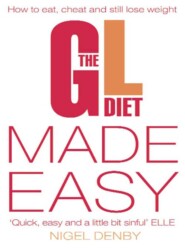По всем вопросам обращайтесь на: info@litportal.ru
(©) 2003-2024.
✖
The 7-Day GL Diet: Glycaemic Loading for Easy Weight Loss
Автор
Год написания книги
2019
Настройки чтения
Размер шрифта
Высота строк
Поля
With a combined 90 years of dieting experience between us, we created Diet Freedom to help other people just like us, people with busy, pressured lives who were frustrated with the continual cycle of either preparing for the next diet, or recovering from the most recent dieting failure. Along with our individual professional strengths – tireless researcher, amazingly experimental cook and diligent dietician – this experience puts us in a unique position to support you in your own quest for diet freedom.
You may notice throughout the book references to both our website www.dietfreedom.co.uk and Diet Freedom Fighters. The name ‘Diet Freedom Fighters’ was coined by GL dieters on our website forums, who have taken up the GL challenge and are getting great results. We set up the website as an added support network and are delighted that it is so popular, not to mention huge fun. We love it and wanted to make sure you are aware that there is a lot more support available to you after reading the book – in fact, there’s a whole community out there waiting to welcome you!
We really hope this book will give you the answers you have been looking for. We’d like to be the first to congratulate you on taking your first step towards success and achieving your goals!
Nigel Denby
Registered Dietician
RD BSc Hons
PART I WHAT IS GL? (#u54f38a44-3770-5e23-9063-ebac940a1626)
This section gives you all the background information about the diet and how it works. Most importantly, it tells you how to get started. It also explains why we feel the Glycaemic Load (GL) makes more sense than the Glycaemic Index (GI) alone, and gives you the simple science behind balancing blood sugars and permanent weight control.
You’ll find:
A simple explanation of how the diet works
A clear guide to getting started
Tips on deciding what you want to achieve
“After I had my son I’d gained about 10lb, and in the first few months I was so busy getting used to being a mum I didn’t really have time to think about dieting. As the day to go back to work loomed closer and closer I began to panic. I’d got into a snacking habit that I just couldn’t seem to break. I’d worked with Nigel on nutrition stories before, and after he talked me through the diet I quickly got back in control of my eating, and lost the weight I’d gained in time for my first day back at work. I felt so reassured that I hadn’t needed to rely on a quick-fix diet. The concept of GL makes complete sense to me and has just become a way of life.”
Mishal Husain, BBC news anchor
Chapter 1 GI AND GL MADE SIMPLE (#u54f38a44-3770-5e23-9063-ebac940a1626)
The first thing you probably want to know about this diet is: ‘Does it work?’
Well, from my experience as a dietician working with patients in my own clinics, I can tell you yes, it most certainly does. Every day I see more and more people who previously thought they were stuck in a ‘diet trap’ telling me that the GL diet is finally getting them back in the driving seat where their weight is concerned. They are looking at life with renewed optimism and excitement as a world of possibilities and freedom opens up to them with every positive step they take towards their weight-loss goals.
Slow Carbs not No Carbs
Before we start looking at GI and GL and the differences in more detail, we need to go back a little further so you can see how our understanding of carbohydrate management has evolved.
A few years ago I was actively and publicly criticizing the ‘high-protein, low-carb’ diet phenomenon that was sweeping the world. We knew people were losing weight, but as a responsible dietician I could never sit comfortably with the idea of cutting out a whole food group from our diet.
What we can say about high-protein, low-carb diets today is this: in controlled weight-loss studies, they perform no better than any other weight-loss programme in the long term, and worryingly we remain unsure about how safe these diets are in terms of heart health and long-term kidney function.
So, let’s get one thing straight: this is not a no-carb diet. The principle behind the GL diet is SLOW CARBS, and there’s a big difference in terms of success and long-term health.
Although research into the Glycaemic Index (GI) has been carried out progressively over the last 20 or so years in Australia (University of Sydney) and Canada (University of Toronto), and more recently in the United States by Harvard Medical School, * (#ulink_05a5892e-d3ba-5bfb-bc8e-5627fa694d86) the GI only really began to hit the headlines a couple of years ago as a possible, healthier successor to low-carb diets.
How Can the GI Help Weight Control?
Foods that contain carbohydrates have an effect on our blood glucose (or blood sugars). This effect is measured as the ‘glycaemic response’. A food that will make our blood glucose level rise quickly is classed as high glycaemic, whereas a food that has little or no impact on our blood glucose is low glycaemic.
When we eat high-glycaemic carbohydrates we get a rapid rise in blood glucose or a ‘spike’. This is bad news for the body and prompts our pancreas to produce insulin, the most powerful hormone in the body, so not to be underestimated. Insulin comes rushing in to flush the glucose from our bloodstream as a safety mechanism and carries it to our liver and muscles, where it is stored as energy for later use. Healthy blood glucose is quite finely balanced – when blood glucose goes too low or too high it can detrimentally affect most of the organs in the body. If this situation becomes the norm it can have quite serious long-term health implications. The muscles and liver fill up very quickly, especially if we are not doing a lot of exercise to use up this ‘stored energy’ – by ‘a lot’ we mean the sort of training you might do to run a marathon. When the muscles and liver are full and can’t store any more glucose, the only thing insulin can do is transfer the excess to other body tissues, where this excess energy is stored as FAT. Yes, those awful wobbly bits!
Once insulin has done its job and dispersed the glucose from our blood, the ‘spike’ in blood glucose falls rapidly. This is a vicious cycle as the rapid fall prompts us to crave more high-glycaemic foods – which actually caused the problem in the first place!
If we eat low-glycaemic foods, we store less excess energy and blood glucose levels are kept stable. This gives a slow-release, prolonged energy supply, enabling us to go about our activities with fewer cravings, feeling more balanced and ultimately storing less fat.
That’s the basis of all low-glycaemic diets. But why low GL (Glycaemic Load) rather than low GI (Glycaemic Index)?
So What’s Wrong with GI?
In principle nothing, except …
The way the GI of a food is worked out doesn’t always relate to the amount of food we actually eat at one sitting.
GI can be very confusing.
If you base your diet on low-GI foods, some very healthy foods are excluded, such as carrots, watermelon, parsnips, pumpkin and broad beans to name a few.
GI gives us the first part of the story. It tells us that not all carbohydrates are equal. But that’s a bit like knowing that you spend more money than you earn each month – it doesn’t actually help you manage your money and get back in the black!
What’s So Right about GL?
The Glycaemic Load (GL) gives you the whole story:
GL allows you to understand with confidence how foods will affect your body.
GL is based on carbohydrates in the portion sizes we usually eat, rather than the amount needed in a laboratory setting to work out the GI.
GL means far more food choices.
GL makes practical sense of the GI science. It’s the final chapter in carbohydrate management and offers a real solution to long-term weight control.
The Technical Bit – How We Work out the GI and GL of a Food
Note: if you don’t want to know about the science – and you don’t need to in order to follow the GL diet – then skip to Chapter 2 (#ulink_2d8a9337-8711-592d-a393-f47b25ff9570).
GI – the First Part of the Story
To work out the GI of a food, scientists take whatever amount of a food is needed to give you 50g of carbohydrate. Now, with a food like bread that isn’t a problem because two slices of bread give us about 50g of carbohydrate. The bread is then fed to human volunteers and blood samples are taken from them at regular intervals to see how much glucose has been released into their bloodstream. The result of these tests is a GI number between 1 and 100.
Foods are classed as:
55 or less = low Gl
56–69 = moderate GI
70 plus = high Gl
So far, so good.









